A Systematic Review of Insole Sensor Technology: Recent Studies and Future Directions
Abstract
1. Introduction
2. Materials and Methods
3. Results
3.1. Overview of Research Articles on “Sensorized” Insoles
3.2. Sensor Technologies Available on the Market
4. Insole Sensor Technology
4.1. Pressure Sensors
4.1.1. Capacitive
4.1.2. Piezoresistive
4.1.3. Piezoelectric
4.2. Inertial Measurement Unit(s)
4.3. Other Types of Sensors
4.4. Combination of Sensors and Systems
4.5. Sensor Placement
4.6. Sensor Size and Number
4.7. Applications
4.7.1. Rehabilitation
4.7.2. Performance
5. Discussion
6. Research Challenges and Future Perspectives
7. Conclusions
Author Contributions
Funding
Institutional Review Board Statement
Informed Consent Statement
Data Availability Statement
Conflicts of Interest
References
- Yang, L.; Amin, O.; Shihada, B. Intelligent Wearable Systems: Opportunities and Challenges in Health and Sports. ACM Comput. Surv. 2024, 56, 1–42. [Google Scholar] [CrossRef]
- McDevitt, S.; Hernandez, H.; Hicks, J.; Lowell, R.; Bentahaikt, H.; Burch, R.; Ball, J.; Chander, H.; Freeman, C.; Taylor, C.; et al. Wearables for Biomechanical Performance Optimization and Risk Assessment in Industrial and Sports Applications. Bioengineering 2022, 9, 33. [Google Scholar] [CrossRef] [PubMed]
- Almuteb, I.; Hua, R.; Wang, Y. Smart insoles review (2008-2021): Applications, potentials, and future. Smart Health 2022, 25, 100301. [Google Scholar] [CrossRef]
- Amaro, C.M.; Castro, M.A.; Roseiro, L.; Neto, M.A.; Amaro, A.M. Plantar Pressure Evaluation during the Season in Five Basketball Movements. Appl. Sci. 2020, 10, 8691. [Google Scholar] [CrossRef]
- Chen, J.; Dai, Y.; Grimaldi, N.S.; Lin, J.; Hu, B.; Wu, Y.; Gao, S. Plantar Pressure-Based Insole Gait Monitoring Techniques for Diseases Monitoring and Analysis: A Review. Adv. Mater. Technol. 2022, 7, 2100566. [Google Scholar] [CrossRef]
- Stöggl, T.; Martiner, A. Validation of Moticon’s OpenGo sensor insoles during gait, jumps, balance and cross-country skiing specific imitation movements. J. Sports Sci. 2017, 35, 196–206. [Google Scholar] [CrossRef] [PubMed]
- Page, M.J.; McKenzie, J.E.; Bossuyt, P.M.; Boutron, I.; Hoffmann, T.C.; Mulrow, C.D.; Shamseer, L.; Tetzlaff, J.M.; Akl, E.A.; Brennan, S.E.; et al. The PRISMA 2020 statement: An updated guideline for reporting systematic reviews. BMJ 2021, 372, n71. [Google Scholar] [CrossRef] [PubMed]
- Elstub, L.J.; Nurse, C.A.; Grohowski, L.M.; Volgyesi, P.; Wolf, D.N.; Zelik, K.E. Tibial bone forces can be monitored using shoe-worn wearable sensors during running. J. Sports Sci. 2022, 40, 1741–1749. [Google Scholar] [CrossRef] [PubMed]
- Parati, M.; Gallotta, M.; Muletti, M.; Pirola, A.; Bellafà, A.; De Maria, B.; Ferrante, S. Validation of Pressure-Sensing Insoles in Patients with Parkinson’s Disease during Overground Walking in Single and Cognitive Dual-Task Conditions. Sensors 2022, 22, 6392. [Google Scholar] [CrossRef]
- Chatzaki, C.; Skaramagkas, V.; Tachos, N.; Christodoulakis, G.; Maniadi, E.; Kefalopoulou, Z.; Fotiadis, D.I.; Tsiknakis, M. The Smart-Insole Dataset Gait Analysis Using Wearable Sensors with a Focus on Elderly and Parkinson’s Patients. Sensors 2021, 21, 2821. [Google Scholar] [CrossRef] [PubMed]
- Nazarahari, M.; Khandan, A.; Khan, A.; Rouhani, H. Foot angular kinematics measured with inertial measurement units: A reliable criterion for real-time gait event detection. J. Biomech. 2022, 130, 110880. [Google Scholar] [CrossRef] [PubMed]
- Sanseverino, G.; Krumm, D.; Kilian, W.; Odenwald, S. Estimation of hike events and temporal parameters with body-attached sensors. Sports Eng. 2023, 26, 18. [Google Scholar] [CrossRef]
- Howcroft, J.; Kofman, J.; Lemaire, E.D.; McIlroy, W.E. Analysis of dual-task elderly gait in fallers and non-fallers using wearable sensors. J. Biomech. 2016, 49, 992–1001. [Google Scholar] [CrossRef] [PubMed]
- Tan, Y.; Ivanov, K.; Mei, Z.; Li, H.; Li, H.; Lubich, L.; Wang, C.; Wang, L. A Soft Wearable and Fully-Textile Piezoresistive Sensor for Plantar Pressure Capturing. Micromachines 2021, 12, 110. [Google Scholar] [CrossRef] [PubMed]
- Thi Thu Vu, H.; Dong, D.; Cao, H.-L.; Verstraten, T.; Lefeber, D.; Vanderborght, B.; Geeroms, J. A Review of Gait Phase Detection Algorithms for Lower Limb Prostheses. Sensors 2020, 20, 3972. [Google Scholar] [CrossRef] [PubMed]
- Ramirez-Bautista, J.A.; Huerta-Ruelas, J.A.; Chaparro-Cárdenas, S.L.; Hernández-Zavala, A. A Review in Detection and Monitoring Gait Disorders Using In-Shoe Plantar Measurement Systems. IEEE Rev. Biomed. Eng. 2017, 10, 299–309. [Google Scholar] [CrossRef] [PubMed]
- Van Nguyen, L.; La, H.M. Real-Time Human Foot Motion Localization Algorithm With Dynamic Speed. IEEE Trans. Hum. Mach. Syst. 2016, 46, 822–833. [Google Scholar] [CrossRef]
- Seçkin, A.Ç.; Ateş, B.; Seçkin, M. Review on Wearable Technology in Sports: Concepts, Challenges and Opportunities. Appl. Sci. 2023, 13, 10399. [Google Scholar] [CrossRef]
- Li, M.; Wang, Y.; Fan, X.; Huang, H.; Wan, Y.; Li, Y.; Fang, J.; Gao, J.; Yang, Y.; Liu, J. A Conductive Bamboo Fabric with Controllable Resistance for Tailoring Wearable Sensors. ACS Appl. Mater. Interfaces 2022, 14, 26958–26969. [Google Scholar] [CrossRef] [PubMed]
- Annabestani, M.; Esmaeili-Dokht, P.; Olyanasab, A.; Orouji, N.; Alipour, Z.; Sayad, M.H.; Rajabi, K.; Mazzolai, B.; Fardmanesh, M. A new 3D, microfluidic-oriented, multi-functional, and highly stretchable soft wearable sensor. Sci. Rep. 2022, 12, 20486. [Google Scholar] [CrossRef] [PubMed]
- Guo, R.; Cheng, X.; Hou, Z.-C.; Ma, J.-Z.; Zheng, W.-Q.; Wu, X.-M.; Jiang, D.; Pan, Y.; Ren, T.-L. A Shoe-Integrated Sensor System for Long-Term Center of Pressure Evaluation. IEEE Sens. J. 2021, 21, 27037–27044. [Google Scholar] [CrossRef]
- Baniasad, M.; Martin, R.; Crevoisier, X.; Pichonnaz, C.; Becce, F.; Aminian, K. Automatic Body Segment and Side Recognition of an Inertial Measurement Unit Sensor during Gait. Sensors 2023, 23, 3587. [Google Scholar] [CrossRef] [PubMed]
- Ho, J.G.; Kim, Y.; Min, S.D. Customized Textile Capacitive Insole Sensor for Center of Pressure Analysis. Sensors 2022, 22, 9390. [Google Scholar] [CrossRef] [PubMed]
- Jacobs, D.A.; Ferris, D.P. Estimation of ground reaction forces and ankle moment with multiple, low-cost sensors. J. Neuroeng. Rehabil. 2015, 12, 90. [Google Scholar] [CrossRef] [PubMed]
- Pan, Z.; Gao, H.; Chen, Y.; Xie, Z.; Xie, L. Evaluation of Hemiplegic Gait Based on Plantar Pressure and Inertial Sensors. IEEE Sens. J. 2023, 23, 12008–12017. [Google Scholar] [CrossRef]
- Chen, W.; Xu, Y.; Wang, J.; Zhang, J. Kinematic Analysis of Human Gait Based on Wearable Sensor System for Gait Rehabilitation. J. Med. Biol. Eng. 2016, 36, 843–856. [Google Scholar] [CrossRef]
- Moon, J.; Jung, J.; Kang, E.; Choi, S.I. Open Set User Identification Using Gait Pattern Analysis Based on Ensemble Deep Neural Network. IEEE Sens. J. 2022, 22, 16975–16984. [Google Scholar] [CrossRef]
- Howcroft, J.; Kofman, J.; Lemaire, E.D. Prospective Fall-Risk Prediction Models for Older Adults Based on Wearable Sensors. IEEE Trans. Neural Syst. Rehabil. Eng. 2017, 25, 1812–1820. [Google Scholar] [CrossRef]
- Lin, F.; Wang, A.; Zhuang, Y.; Tomita, M.R.; Xu, W. Smart Insole: A Wearable Sensor Device for Unobtrusive Gait Monitoring in Daily Life. IEEE Trans. Ind. Inform. 2016, 12, 2281–2291. [Google Scholar] [CrossRef]
- Hegde, N.; Sazonov, E. Smartstep: A fully integrated, low-power insole monitor. Electronics 2014, 3, 381–397. [Google Scholar] [CrossRef]
- He, Y.; Lin, M.; Wang, X.; Liu, K.; Liu, H.; He, T.; Zhou, P. Textile-film sensors for a comfortable intelligent pressure-sensing insole. Measurement 2021, 184, 109943. [Google Scholar] [CrossRef]
- Li, G.; Liu, T.; Yi, J. Wearable Sensor System for Detecting Gait Parameters of Abnormal Gaits: A Feasibility Study. IEEE Sens. J. 2018, 18, 4234–4241. [Google Scholar] [CrossRef]
- Prasanth, H.; Caban, M.; Keller, U.; Courtine, G.; Ijspeert, A.; Vallery, H.; von Zitzewitz, J. Wearable Sensor-Based Real-Time Gait Detection A Systematic Review. Sensors 2021, 21, 2727. [Google Scholar] [CrossRef] [PubMed]
- González, I.; Fontecha, J.; Hervás, R.; Bravo, J. An ambulatory system for gait monitoring based on wireless sensorized insoles. Sensors 2015, 15, 16589. [Google Scholar] [CrossRef] [PubMed]
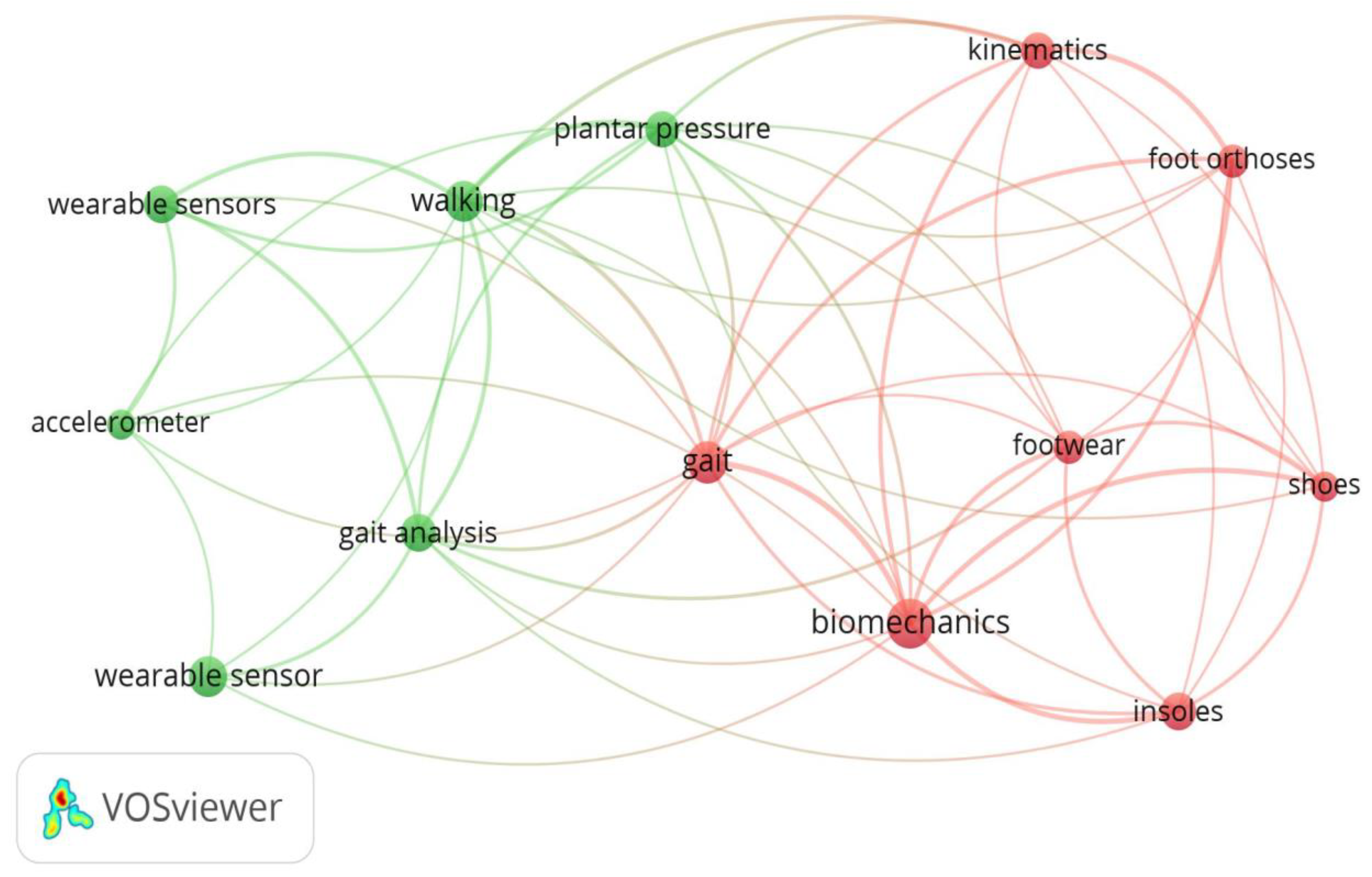
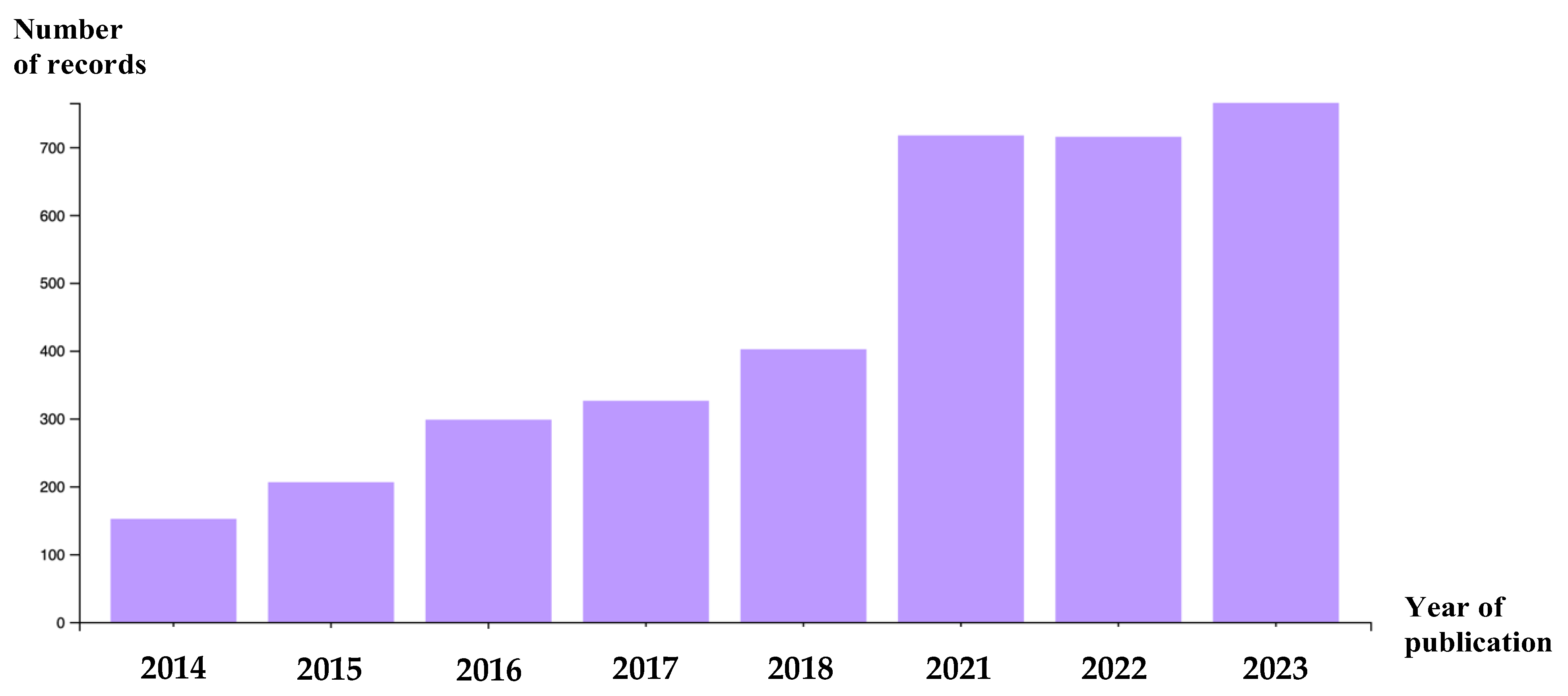
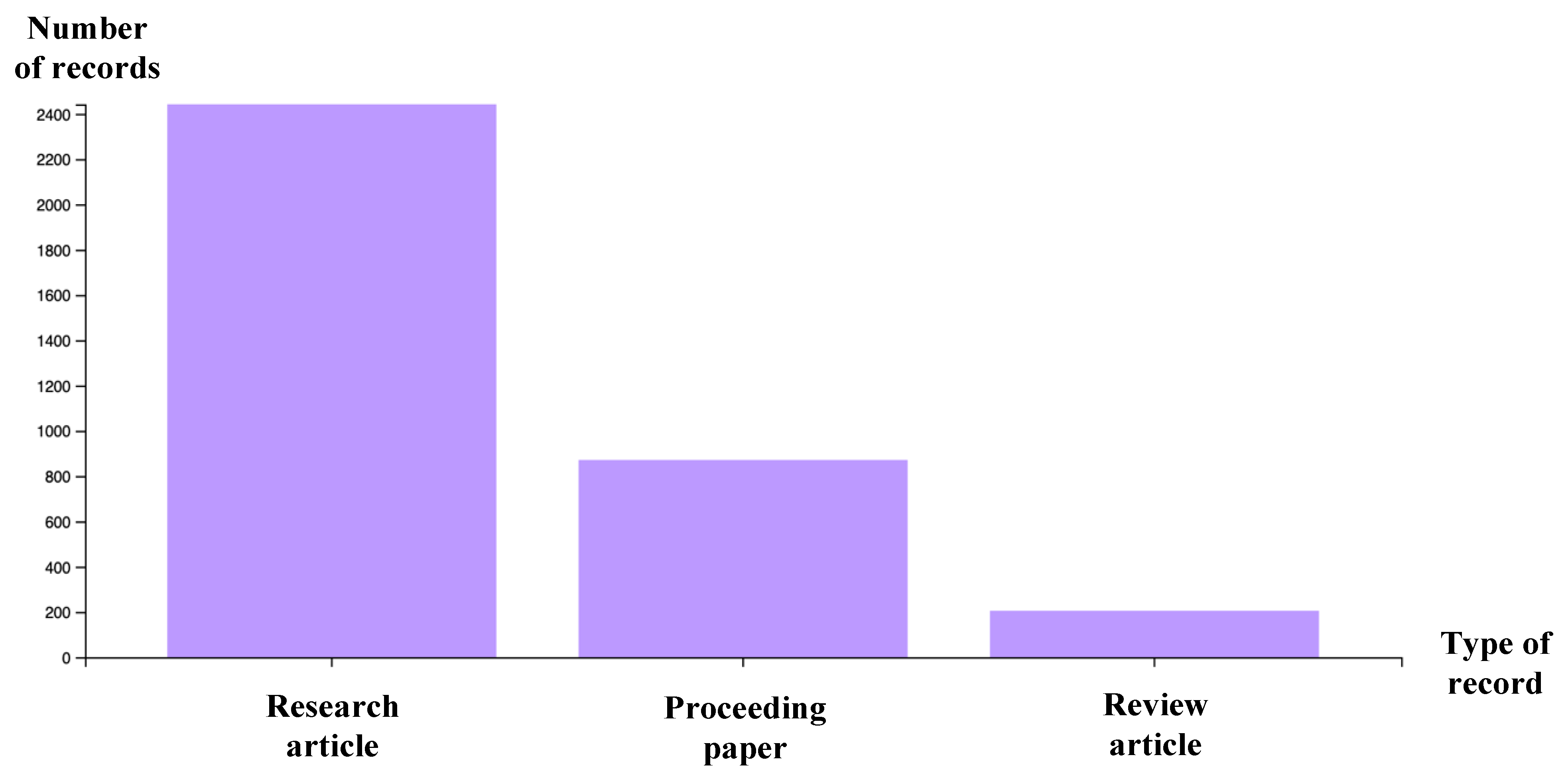
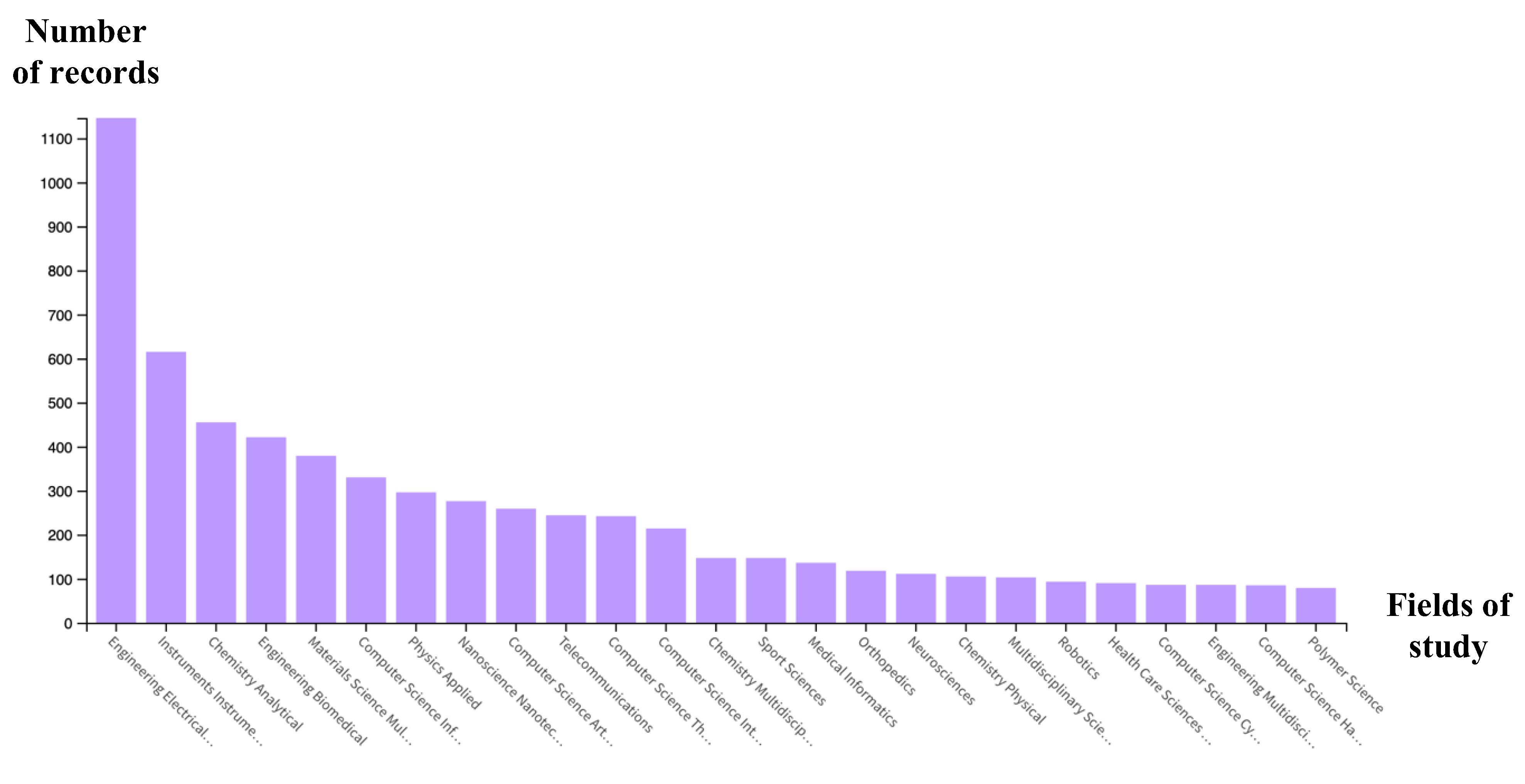
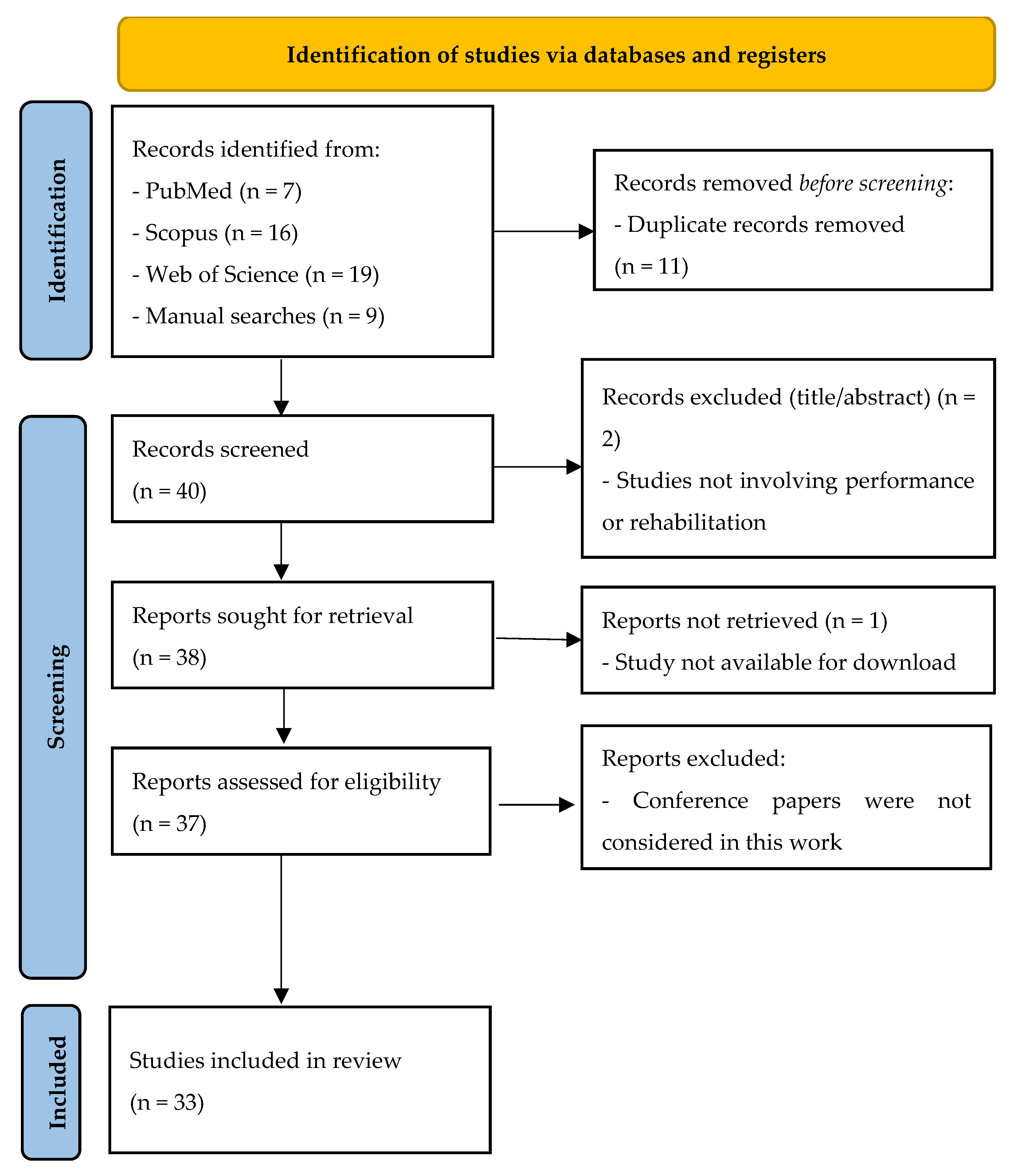
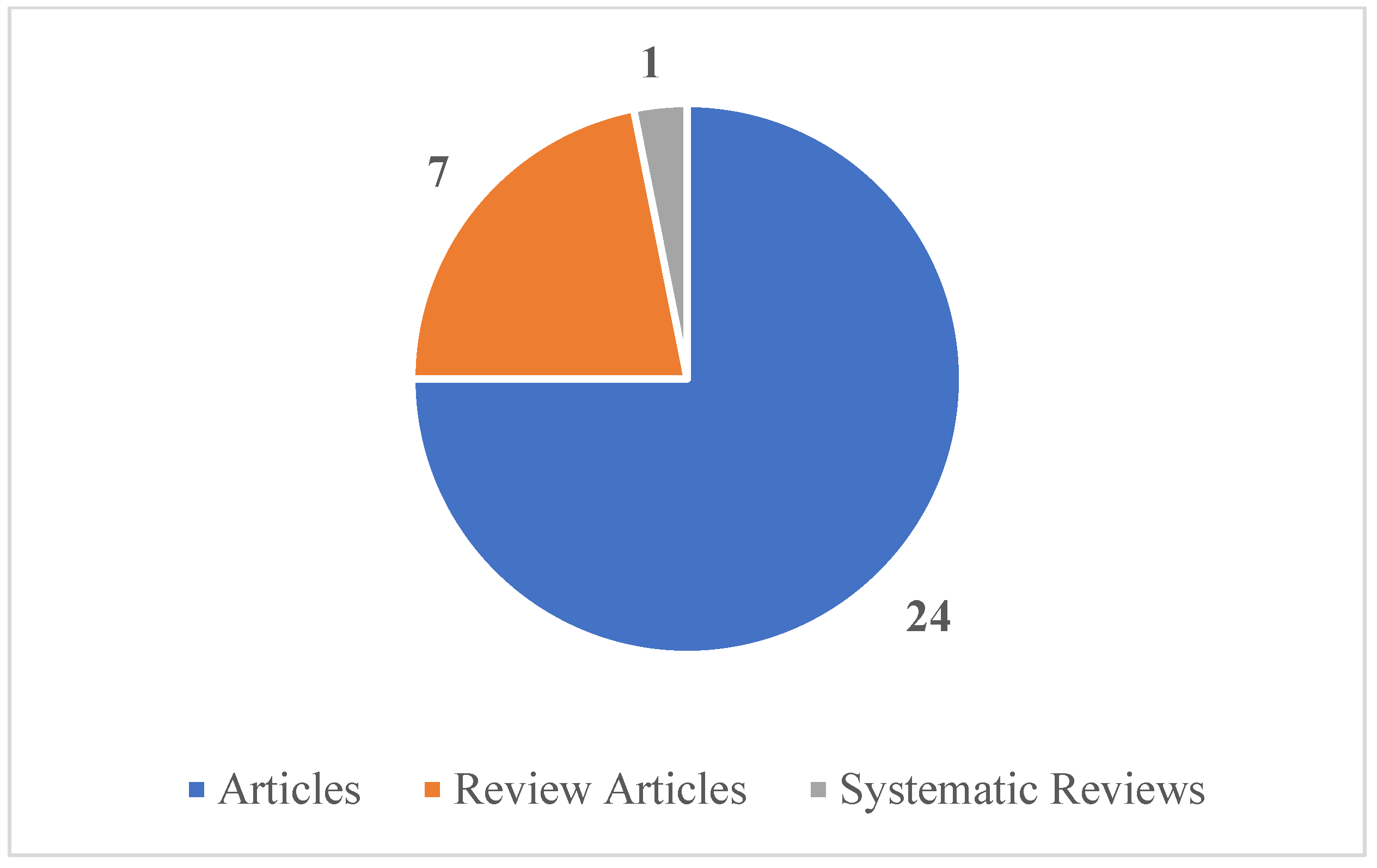
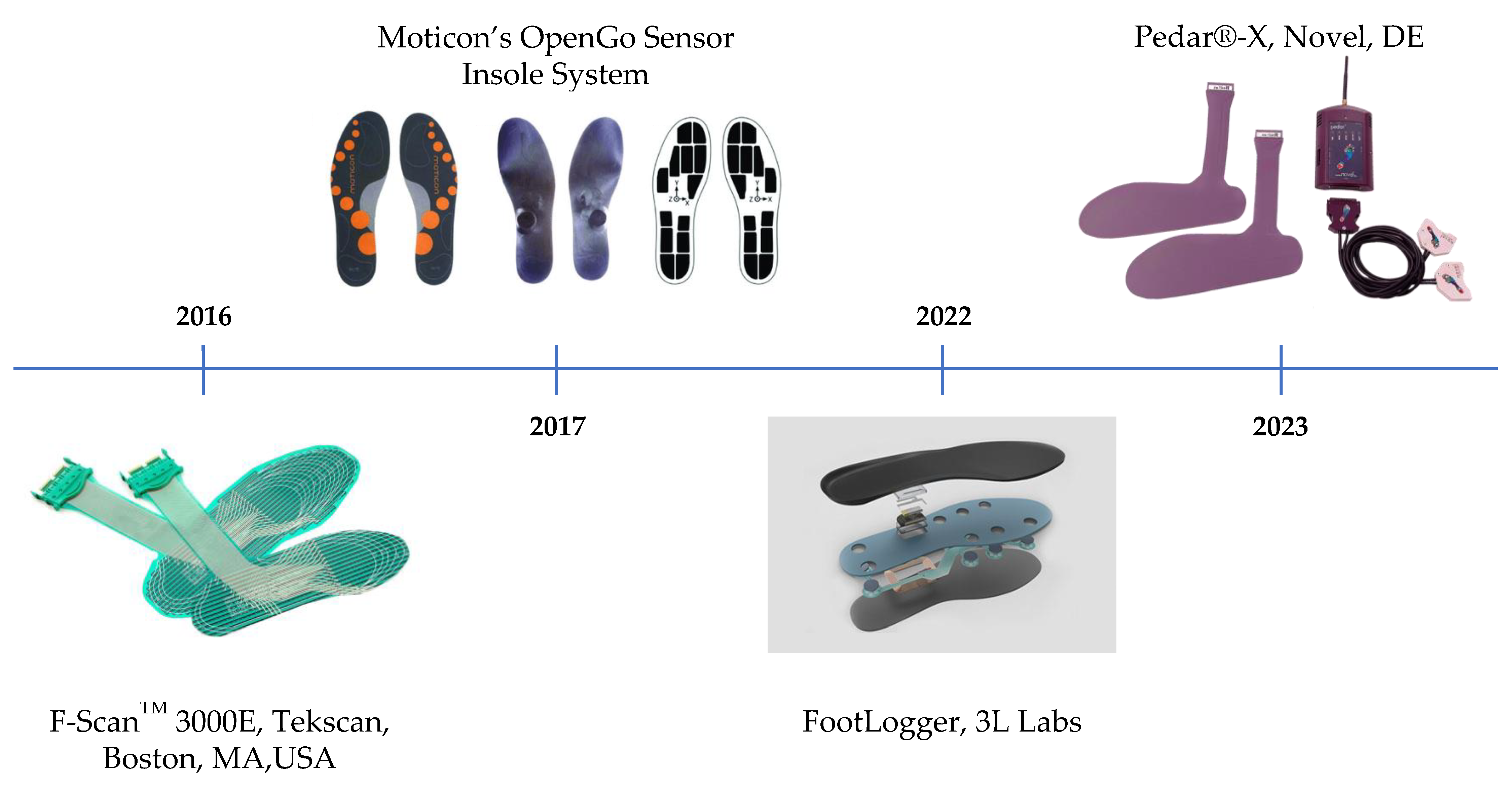
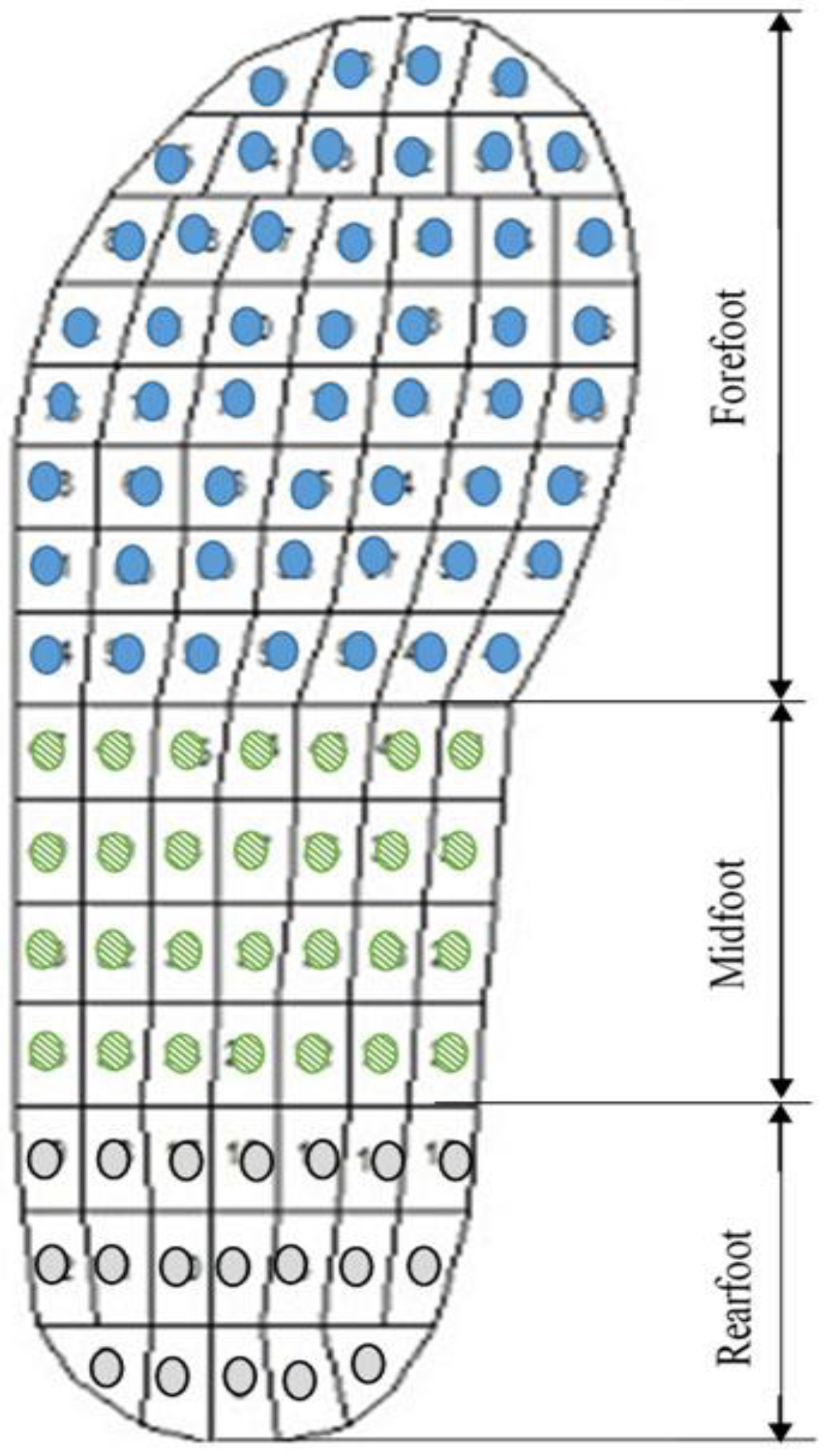
| Database Name | Platform | Date Coverage | Date of Search | Search Within | Source Title | Command | # of Results |
|---|---|---|---|---|---|---|---|
| Scopus | Elsevier | 2014–2024 | 30 April 2024 | Article Title, Abstract, Keywords | All | “wearable sensor” OR “wearable sensors” AND “insole” OR “insoles” AND “biomechanics” | 51 |
| Scopus | Elsevier | 2014–2024 | 30 April 2024 | Article Title, Abstract, Keywords | All | “wearable sensor” OR “wearable sensors” AND “insole” OR “insoles” | 51 |
| Scopus | Elsevier | 2019–2024 | 30 April 2024 | Article Title, Abstract, Keywords | All | “wearable sensor” OR “wearable sensors” AND “insole” OR “insoles” AND “biomechanics” | 41 |
| Scopus | Elsevier | 2019–2024 | 30 April 2024 | Article Title, Abstract, Keywords | All | “wearable sensor” OR “wearable sensors” AND “insole” OR “insoles” | 41 |
| Web of Science | Clarivate | –2024 | 30 April 2024 | All Fields | All | “wearable sensor” OR “wearable sensors” AND “insole” OR “insoles” AND “biomechanics” | 3508 * |
| Web of Science | Clarivate | 2006–2024 | 30 April 2024 | Article Title, Abstract, Author Keywords | All | “wearable sensor” OR “wearable sensors” AND “insole” OR “insoles” AND “biomechanics” | 105 |
| Web of Science | Clarivate | 2014–2024 | 30 April 2024 | Article Title, Abstract, Author Keywords | All | “wearable sensor” OR “wearable sensors” AND “insole” OR “insoles” AND “biomechanics” | 90 |
| Web of Science | Clarivate | 2019–2024 | 30 April 2024 | Article Title, Abstract, Author Keywords | All | “wearable sensor” OR “wearable sensors” AND “insole” OR “insoles” AND “biomechanics” | 68 |
| PubMed | NLB/NIH | 2014–2024 | 2 May 2024 | All Fields | All | “wearable sensor” OR “wearable sensors” AND “smart insole” OR “smart insoles” AND “insole” AND “performance” AND “rehabilitation” | 3 |
| PubMed | NLB/NIH | 2014–2024 | 2 May 2024 | All Fields | All | “wearable sensor” AND “insole” AND (“performance” OR “rehabilitation”) | 7 ** |
| Web of Science | Clarivate | Until 2024 | 2 May 2024 | Article Title, Abstract, Author Keywords | All | “wearable sensor” OR “wearable sensors” AND “smart insole” OR “smart insoles” OR “insole” AND “performance” AND “rehabilitation” | 88 |
| Web of Science | Clarivate | Until 2024 | 2 May 2024 | All Fields | All | “wearable sensor” AND “insole” AND (“performance” OR “rehabilitation”) | 19 ** |
| Scopus | Elsevier | Until 2024 | 2 May 2024 | Article Title, Abstract, Keywords | All | “wearable sensor” OR “wearable sensors” AND “smart insole” OR “smart insoles” AND “insole” AND “performance” AND “rehabilitation” | 4 |
| Scopus | Elsevier | Until 2024 | 2 May 2024 | Keywords | All | “wearable sensor” AND “insole” AND (“performance” OR “rehabilitation”) | 16 ** |
| Study/Work | Year of Publication | Type of Document | Focus of Study | Equipment | Types of Sensors | Number of Sensors in Insole | Wireless (Yes/No) | Number of Articles Included |
|---|---|---|---|---|---|---|---|---|
| [8] | 2022 | Research article | Monitoring of forces applied to the tibial bone | Shoes and insoles | Inertial measurement unit (IMU) and pressure sensors | ND * | Y | 49 |
| [9] | 2022 | Research article | Validation of pressure-sensing insoles in patients with Parkinson’s disease | Insoles | IMU and pressure sensors | 6-axis IMU; 18 | Y | 42 |
| [10] | 2021 | Research article | Gait analysis using smart insoles in elderly people and Parkinson patients | Insoles | IMU and pressure sensors | 6-axis IMU; 16 | Y | 54 |
| [11] | 2022 | Research article | Real-time gait event detection/foot angular kinematics with IMU | Plastic plates | IMU and pressure sensors | tri-axial accelerometer, tri-axial gyroscope, and tri-axial magnetometer; Pedar-X, Novel, DE with 99 each | N | 31 |
| [12] | 2023 | Research article | Estimation and analysis of human gait | Insoles | IMUs and pressure sensors | Sensor node; 3-axis accelerometer and gyroscope; 8 each | N | 13 |
| [13] | 2016 | Research article | Analysis of gait in fallers and non-fallers in the elderly population | Bands, belt, and insoles | IMUs and pressure sensors | Tri-axial accelerometers at the head, pelvis, and left and right shanks; pressure-sensing insoles (F-Scan 3000E, Tekscan, Boston, MA, USA) with 954 each | N | 46 |
| [14] | 2021 | Research article | Collecting and monitoring plantar pressure | Insoles | Piezoresistive sensors | 6 textile piezoresistive sensors (TPRS) each | ND * | 38 |
| [15] | 2020 | Review article | Gait phase detection in lower limb prostheses | ND * | IMU, pressure sensors, ground reaction force (GRF) sensor, angular sensors, and force sensors (FSs) | Force-sensing resistors (FSRs), force sensors such as footswitches and foot-pressure insoles | Y/N | 98 |
| [16] | 2017 | Review article | Detection and monitoring gait disorders | Insoles | IMU and pressure sensors | 1–64 | Y/N | 105 |
| [5] | 2022 | Review article | Plantar-pressure-based insole gait monitoring techniques for disease monitoring and analysis | Insoles | IMU and pressure sensors | 4–16 | Y/N | 229 |
| [1] | 2024 | Review article | Intelligent wearable systems in health and sports | Camera, smartwatch, IMU smart ring, smart shirt, smart insole | IMUs (accelerometer, gyroscope), magnetometer, MIMU (magneto-inertial measurement unit), bioelectric sensors, biometric sensors, environmental sensors, optical and chemical sensors, flexible sensors | ND * | Y/N | 296 |
| [17] | 2016 | Research article | Real-time human foot motion | Shoe | IMUs (accelerometer, gyroscope, and magnetometer) | 3 | N | 40 |
| [18] | 2023 | Review article | Wearable technology in sports | Wearable technology (WT) | Physiological, environmental, biomechanical, and location sensors | ND * | Y/N | 191 |
| [3] | 2022 | Review article | Smart insoles | Insole | Accelerometer, gyroscope, IMU, pressure sensors, piezoresistive sensors, capacitive sensors, temperature sensor | ND * | Y/N | 175 |
| [6] | 2017 | Research article | Validation of Moticon’s OpenGo sensor insoles during gait, jumps, balance, and cross-country skiing | OpenGo sensor insole system, PedarX sensor insole, AMTI force-plate systems, and neutral shoes | Capacitive sensors | 16 pressure sensors and 6-axis IMU; 99 pressure sensors | Y/N | 23 |
| [2] | 2022 | Review article | Wearables for biomechanical performance optimization and risk assessment | WT | Exoskeletons, IMU, pressure sensors, surface electromyography (EMG) | ND * | Y/N | 73 |
| [19] | 2022 | Research article | A conductive bamboo fabric with controllable resistance for tailoring wearable sensors | Sleeves and insoles | Strain and pressure sensors | 4 each | N | 28 |
| [20] | 2022 | Research article | A new 3D, microfluidic-oriented, multi-functional, and highly stretchable soft wearable sensor | Insole, bands (for the wrist, elbow, and knee) | 3D soft sensors (resistive sensors) | 2 | N | 51 |
| [21] | 2021 | Research article | A shoe-integrated sensor system for pressure evaluation | Shoe and insole | FSR sensors | 5 FSR sensors and 8 pressure sensors | Y | 17 |
| [22] | 2023 | Research article | Automatic body-segment and side recognition of an IMU sensor during gait | Bands, force plates, insole | IMUs (tri-axial angular velocity and acceleration sensors) and pressure sensors (capacitive) | Pedar-X, Novel, DE with 99 each | N | 44 |
| [23] | 2022 | Research article | Customized textile capacitive insole sensor for center-of-pressure analysis | Insole | Textile capacitive sensor (pressure sensors) | 10 each | N | 29 |
| [24] | 2015 | Research article | Estimation of ground reaction forces and ankle moment | Orthopedic shoe with an insole, force plates | Tissue force sensor (pressure sensors) | 8 each | N | 29 |
| [25] | 2023 | Research article | Evaluation of hemiplegic gait based on plantar pressure and inertial sensors | Insole | IMUs (gyroscope, magnetometer, accelerometer) and pressure sensors | 7 IMUs and 2 pressure insoles | N | 38 |
| [26] | 2016 | Research article | Kinematic analysis of human gait based on wearable sensor system for gait rehabilitation | Shoe and insole | FSRs and accelerometer | 7 FSRs, triaxial accelerometer | N | 36 |
| [27] | 2022 | Research article | Open-set user identification using gait pattern analysis based on an ensemble deep neural network | Insole | IMUs and pressure sensors | FootLogger (8 pressure sensors, 3D-axis accelerometer, and 3D-axis gyroscope). | Y | 52 |
| [28] | 2017 | Research article | Prospective fall-risk prediction models for older adults | Shoe, insole, bands, and belt | IMUs and pressure sensors | Tri-axial accelerometers at the head, pelvis, and left and right shanks; Pressure-sensing insoles (F-Scan 3000E, Tekscan, Boston, MA, USA) with 954 each | N | 44 |
| [29] | 2016 | Research article | Smart insole and gait monitoring in daily life | Insole | IMUs and pressure sensors | Textile-based pressure sensors (48) and IMUs (3-axis accelerometer, 3-axis gyroscope, and 3-axis magnetometer) | Y | 25 |
| [30] | 2014 | Research article | SmartStep: a fully integrated, low-power insole monitor | Shoe and insole | IMU and pressure sensors | 3D accelerometer, 3D gyroscope, and 3 FSR402 pressure sensors | Y | 35 |
| [31] | 2021 | Research article | Textile-film sensors for a comfortable intelligent pressure-sensing insole | Foam insoles with piezoresistive films (pressure-sensing insoles) | Pressure sensors | 4 pressure sensors | N | 35 |
| [32] | 2018 | Research article | Wearable sensor system for detecting gait parameters of abnormal gaits | Smart shoes | Range sensors, force sensors, and inertial sensors | 4 range sensors (VL53L0x, STM, Geneva, Switzerland), 6 force sensors, inertial sensors (MPU9250, InvenSense, USA) each | Y | 36 |
| [33] | 2021 | Systematic review | Wearable-sensor-based real-time gait detection | WT | IMU, insole pressure sensors, EMG sensors | ND * | Y/N | 138 |
| Device Name | Company/Enterprise | Type(s) of Sensor(s) | Number of Sensors in Insole | Wireless (Yes/No) | Application(s) |
|---|---|---|---|---|---|
| Moticon SCIENCE | Moticon (München, Germany) | Pressure sensors, accelerometers, and gyroscopes | 16 pressure sensors and 6-axis IMU | Y | Motion analysis for clinical research and sports science |
| FootLogger | 3L Labs (Chicago, IL, USA) | Pressure sensors | (8 pressure sensors, 3D-axis accelerometer, and 3D-axis gyroscope). | Y | Monitoring foot health for rehabilitation and injury prevention |
| Digitsole | Digitsole (Houston, TX, USA) | IMU | 2 detachable connected sensors | Y | Mobility assessment, follow-up/monitoring on site or remotely, rehabilitation follow-up |
| Nurvv Run | Nurvv (London, UK) | Pressure sensors | 16 each | N | Cadence, step length, foot strike |
| F-Scan | Tekscan (Norwood, MA, USA) | Pressure sensors | 954 each | N | Gait analysis parameters such as pressure and force data |
| Parotec-System | Paromed (Neubeuern, Germany) | Pressure sensors (Piezoresistive) | 24 | N | Gait studies |
| Pedar system | Novel (Munich, Germany) | Pressure sensors (capacitive) | 99 | N | Gait studies |
| BioFoot | IBV (Valencia, Spain) | Pressure sensors (piezoelectric) | 64 | Y | Gait analysis parameters such as pressure |
| OpenGo | Moticon (München, Germany) | Pressure sensors, accelerometers, and temperature sensors | 16 pressure sensors and 6-axis IMU | Y | Gait studies, activity tracking |
| Real-Time Rehab system | Veristride (South Salt Lake, UT, USA) | Pressure sensors | ND * | Y | Gait studies (rehabilitation—amputees) |
| SurroSense Rx (wrist and feet) | Orpyx Medical Technologies (Calgary, Canada) | Pressure sensors | 8 each | Y | Monitoring foot health for rehabilitation and injury prevention (for example, foot ulcers) |
| Kinematix Tune | Kinematix (North Vancouver, Canada) | Pressure sensor and accelerometer | ND * | Y | Feet symmetry analysis regarding ground-contact time, heel contact, foot strike; combines feet information with GPS parameters: speed, distance |
| IDM Perform | JUMPSTARTCSR (North Vancouver, Canada) | Accelerometer and gyroscope | ND * | N | Fitness, medical, and industrial |
Disclaimer/Publisher’s Note: The statements, opinions and data contained in all publications are solely those of the individual author(s) and contributor(s) and not of MDPI and/or the editor(s). MDPI and/or the editor(s) disclaim responsibility for any injury to people or property resulting from any ideas, methods, instructions or products referred to in the content. |
© 2024 by the authors. Licensee MDPI, Basel, Switzerland. This article is an open access article distributed under the terms and conditions of the Creative Commons Attribution (CC BY) license (https://creativecommons.org/licenses/by/4.0/).
Share and Cite
Santos, V.M.; Gomes, B.B.; Neto, M.A.; Amaro, A.M. A Systematic Review of Insole Sensor Technology: Recent Studies and Future Directions. Appl. Sci. 2024, 14, 6085. https://doi.org/10.3390/app14146085
Santos VM, Gomes BB, Neto MA, Amaro AM. A Systematic Review of Insole Sensor Technology: Recent Studies and Future Directions. Applied Sciences. 2024; 14(14):6085. https://doi.org/10.3390/app14146085
Chicago/Turabian StyleSantos, Vítor Miguel, Beatriz B. Gomes, Maria Augusta Neto, and Ana Martins Amaro. 2024. "A Systematic Review of Insole Sensor Technology: Recent Studies and Future Directions" Applied Sciences 14, no. 14: 6085. https://doi.org/10.3390/app14146085
APA StyleSantos, V. M., Gomes, B. B., Neto, M. A., & Amaro, A. M. (2024). A Systematic Review of Insole Sensor Technology: Recent Studies and Future Directions. Applied Sciences, 14(14), 6085. https://doi.org/10.3390/app14146085








